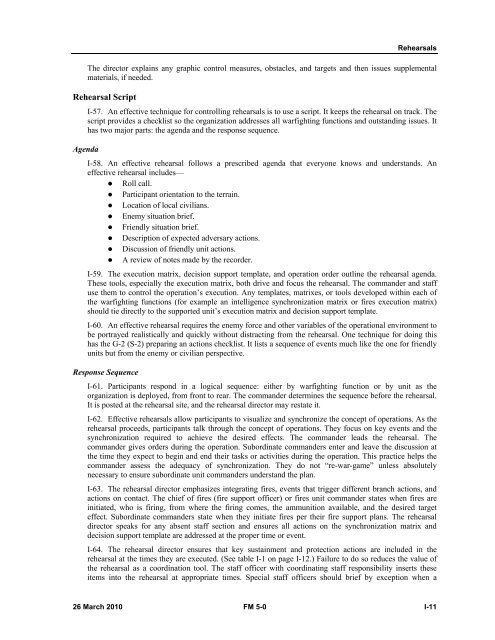FM 5-0, The Operations Process - Federation of American Scientists
FM 5-0, The Operations Process - Federation of American Scientists
FM 5-0, The Operations Process - Federation of American Scientists
You also want an ePaper? Increase the reach of your titles
YUMPU automatically turns print PDFs into web optimized ePapers that Google loves.
Rehearsals<br />
<strong>The</strong> director explains any graphic control measures, obstacles, and targets and then issues supplemental<br />
materials, if needed.<br />
Rehearsal Script<br />
I-57. An effective technique for controlling rehearsals is to use a script. It keeps the rehearsal on track. <strong>The</strong><br />
script provides a checklist so the organization addresses all warfighting functions and outstanding issues. It<br />
has two major parts: the agenda and the response sequence.<br />
Agenda<br />
I-58. An effective rehearsal follows a prescribed agenda that everyone knows and understands. An<br />
effective rehearsal includes—<br />
• Roll call.<br />
• Participant orientation to the terrain.<br />
• Location <strong>of</strong> local civilians.<br />
• Enemy situation brief.<br />
• Friendly situation brief.<br />
• Description <strong>of</strong> expected adversary actions.<br />
• Discussion <strong>of</strong> friendly unit actions.<br />
• A review <strong>of</strong> notes made by the recorder.<br />
I-59. <strong>The</strong> execution matrix, decision support template, and operation order outline the rehearsal agenda.<br />
<strong>The</strong>se tools, especially the execution matrix, both drive and focus the rehearsal. <strong>The</strong> commander and staff<br />
use them to control the operation’s execution. Any templates, matrixes, or tools developed within each <strong>of</strong><br />
the warfighting functions (for example an intelligence synchronization matrix or fires execution matrix)<br />
should tie directly to the supported unit’s execution matrix and decision support template.<br />
I-60. An effective rehearsal requires the enemy force and other variables <strong>of</strong> the operational environment to<br />
be portrayed realistically and quickly without distracting from the rehearsal. One technique for doing this<br />
has the G-2 (S-2) preparing an actions checklist. It lists a sequence <strong>of</strong> events much like the one for friendly<br />
units but from the enemy or civilian perspective.<br />
Response Sequence<br />
I-61. Participants respond in a logical sequence: either by warfighting function or by unit as the<br />
organization is deployed, from front to rear. <strong>The</strong> commander determines the sequence before the rehearsal.<br />
It is posted at the rehearsal site, and the rehearsal director may restate it.<br />
I-62. Effective rehearsals allow participants to visualize and synchronize the concept <strong>of</strong> operations. As the<br />
rehearsal proceeds, participants talk through the concept <strong>of</strong> operations. <strong>The</strong>y focus on key events and the<br />
synchronization required to achieve the desired effects. <strong>The</strong> commander leads the rehearsal. <strong>The</strong><br />
commander gives orders during the operation. Subordinate commanders enter and leave the discussion at<br />
the time they expect to begin and end their tasks or activities during the operation. This practice helps the<br />
commander assess the adequacy <strong>of</strong> synchronization. <strong>The</strong>y do not “re-war-game” unless absolutely<br />
necessary to ensure subordinate unit commanders understand the plan.<br />
I-63. <strong>The</strong> rehearsal director emphasizes integrating fires, events that trigger different branch actions, and<br />
actions on contact. <strong>The</strong> chief <strong>of</strong> fires (fire support <strong>of</strong>ficer) or fires unit commander states when fires are<br />
initiated, who is firing, from where the firing comes, the ammunition available, and the desired target<br />
effect. Subordinate commanders state when they initiate fires per their fire support plans. <strong>The</strong> rehearsal<br />
director speaks for any absent staff section and ensures all actions on the synchronization matrix and<br />
decision support template are addressed at the proper time or event.<br />
I-64. <strong>The</strong> rehearsal director ensures that key sustainment and protection actions are included in the<br />
rehearsal at the times they are executed. (See table I-1 on page I-12.) Failure to do so reduces the value <strong>of</strong><br />
the rehearsal as a coordination tool. <strong>The</strong> staff <strong>of</strong>ficer with coordinating staff responsibility inserts these<br />
items into the rehearsal at appropriate times. Special staff <strong>of</strong>ficers should brief by exception when a<br />
26 March 2010 <strong>FM</strong> 5-0 I-11















